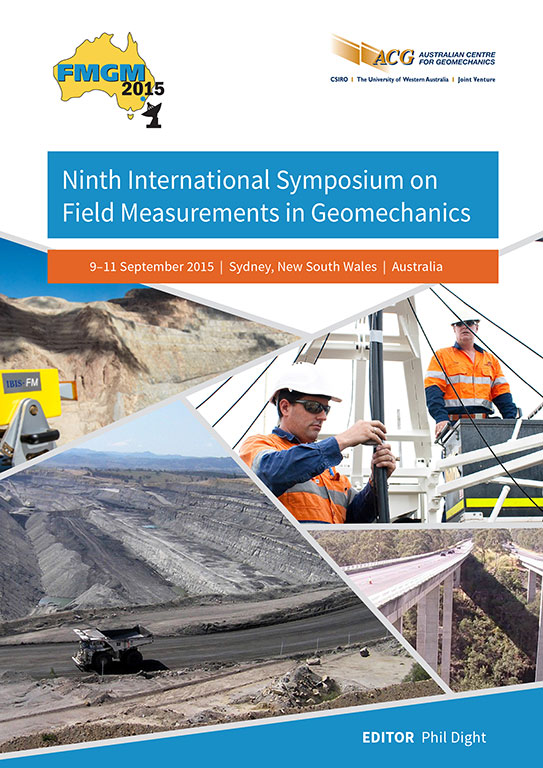Implementation of fibre-optic vertical extensometers for safety monitoring

|
Authors: Rabaiotti, C; Iten, M; Fischli, F |
DOI https://doi.org/10.36487/ACG_rep/1508_45_Fischli
Cite As:
Rabaiotti, C, Iten, M & Fischli, F 2015, 'Implementation of fibre-optic vertical extensometers for safety monitoring', in PM Dight (ed.), FMGM 2015: Proceedings of the Ninth Symposium on Field Measurements in Geomechanics, Australian Centre for Geomechanics, Perth, pp. 631-644, https://doi.org/10.36487/ACG_rep/1508_45_Fischli
Abstract:
The Westlink is one of the major city development projects of the Swiss federal railway company (SBB CFF FFS) in Zürich: three tall office buildings (total 70,000 m2 for office, flats and shops) have been recently constructed in close proximity to the railway tracks. An existing water pipeline of 2.1 m in diameter is running below the buildings at a depth of 10 m. The pipeline is an important component within the city’s water supply system with an internal pressure of 10 bar. To assure the pipeline safety and integrity, an assessment of the tolerable pipeline displacement during construction was carried out and monitoring was implemented. The assessment consisted of modelling the depth-dependent soil deformation during construction using a three-dimensional finite element modelling. The modelling allowed predicted settlement and allowed definition of critical values for the safety of the pipeline. Subsequently, implementation of a sophisticated monitoring system based on fibre-optic sensors and conventional geotechnical monitoring methods was carried out. Thus, the combination of advanced modelling and monitoring allowed reliable risk assessment for the pipeline and the building through all the construction phases.
References:
Benz, T 2007, Small Strain Stiffness and its numerical consequences, PhD thesis, Universität Stuttgart.
Blum, J, Nooner, S & Zumberge, M 2008, ‘Recording earth strain with optical fibers’, IEEE Sensors Journal, vol. 8, no. 7,
pp. 1152-1160.
Brinkgreve, RBJ, Broere, W & Waterman, D 2007, PLAXIS3D foundation user manual, version 2, Delft, Netherlands.
Brinkgreve, RBJ, Engin, E & Swolfs, WM 2013, PLAXIS3D user manual, Delft, Netherlands.
Burland, JB 1989, ‘Small is Beautiful’, Canadian Geotechnical Journal, vol. 26, no. 4, pp. 499-516.
Clayton, CR, Matthews, MC & Simons, NE 1995, Site investigation, 2nd edn, Wiley-Blackwell, Hoboken, New Jersey, USA.
Gysi Leoni Mader AG 2005, Setzungsberechnungen und Überwachungskonzept Schüttung, Parzelle AL 7803, Zürich-Altstetten.
Horiguchi, T & Tateda, M 1989, ‘Optical-fiber-attenuation investigation using stimulated Brillouin scattering between a pulse and a continuous wave’, Optics Letters, vol. 14, no. 8, pp. 408-410.
Iten, M 2011, Novel applications of distributed fiber-optic sensing in geotechnical engineering, PhD thesis, ETH Zürich.
Jäckli Geologie 2008, Geologische Baugrunduntersuchungen Űberbauung WestLink, Zürich.
Lo Presti, DCF, Jamiolkowski, M, Pallara, O, Cavallaro, A & Pedroni, S 1997, ‘Shear modulus and damping of soils’, Geotechnique, vol. 47, no. 3, pp. 603-617.
Nöther, N, Krcmar, M, von der Mark, S, Henninges, J & Reinsch, T 2011, ‘Application of distributed optical fiber sensors to borehole temperature and strain monitoring’, Proceedings of the SENSOR+TEST Conferences, AMA Service GmbH, Wunstorf, Germany, pp. 874-877.
Schanz, T, Vermeer, PA & Bonnier, PG 1999, ‘The hardening soil model: formulation and verification’, Proceedings of the 1st International PLAXIS Symposium: Beyond 2000 in computational geotechnics, Balkema, Rotterdam, 16 p.
Yoshida, Y, Kashiwai, Y, Murakami, E, Ishida, S & Hashiguchi, N 2002, ‘Development of the monitoring system for slope deformations with fiber bragg grating arrays’, Proceedings of SPIE 1694, Smart Structures and Materials 2002, Smart Sensor Technology and Measurement Systems, vol. 296.
© Copyright 2025, Australian Centre for Geomechanics (ACG), The University of Western Australia. All rights reserved.
View copyright/legal information
Please direct any queries or error reports to repository-acg@uwa.edu.au
View copyright/legal information
Please direct any queries or error reports to repository-acg@uwa.edu.au